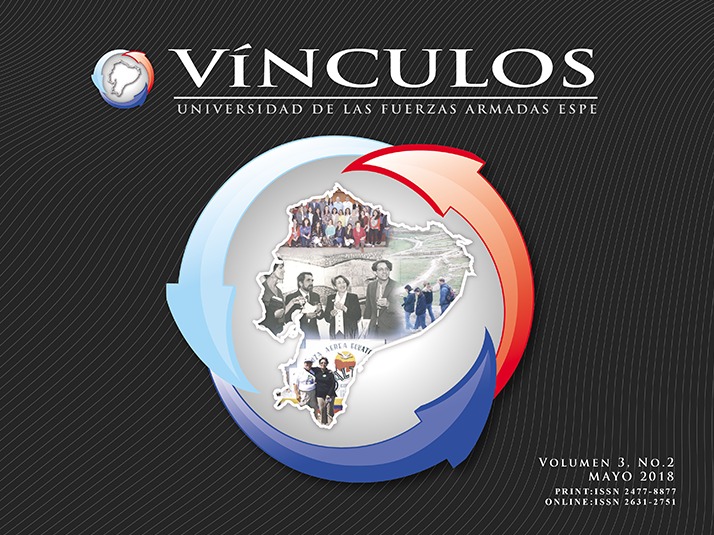

Dear readers,
It is my pleasure to present the “Vínculos – ESPE Volume 3 No. 2 and 3” editions, which are dedicated to celebrating the work of the Fulbright Commission in Ecuador. 2017 was a special year for Fulbright Ecuador as it marked 60 years of building lasting connections and fostering mutual understanding between the people of Ecuador and the United States through cultural and educational exchange. The program offers “Fulbrighters” the opportunity to achieve their professional and personal dreams; resulting in new developments in a diversity of academic fields and lifelong friendships that continue to impact their communities.
What started on February 2017, during the anniversary celebration with a small group of enthusiasts, grew over 11 vibrant contributions from Fulbright Alumni that can be read in this journal. The contributions celebrate the legacy of Senator Fulbright, and the work of the Director of the Fulbright Commission in Ecuador, who inspired all of us. The essays and articles reflect the impact of the scholarship in different science fields.
Thanks to all contributors to these editions, whose life story proves that the saying holds true: “Fulbrigh is a family”. I am also grateful to the editorial team, graphic designer and proofreaders. To conclude, we hope these editions provoke insights into the challenging, but rewarding task of building and maintaining an active Alumni community, as well as advocate for the Fulbright Program.
Enjoy reading!
TANIA ORBE MARTÍNEZ,
IColegio de Comunicación y Artes Contemporáneas, Universidad San Francisco de Quito, Av. Diego de Robles y Vía Interoceánica
torbe@usfq.edu.ec
Susana Cabeza de Vaca no tiene pelos en la lengua. Recuerda con humor cada episodio vivido como un aprendizaje, una meta lograda. Su oficina es amplia en la Mariscal, en pleno centro norte de Quito. La edificación es tan antigua que el piso tiembla cada vez que pasan buses por afuera.
SU PERFIL
Susana Cabeza de Vaca lleva 20 años de directora en la Comisión Fulbright en Ecuador desde 1998. Antes fue profesora de Marketing y Decana de la Escuela de Administración para el Desarrollo en la Universidad San Francisco de Quito. Cuenta con una amplia experiencia comercial en mercadeo, administración de recursos humanos y capacitación corporativa para Textiles Nacionales, S.A. de Quito, Chase Manhattan Bank y Peace Corps.
Pero su formación académica no es en finanzas sino en literatura. Se especializó en el romance y los idiomas clásicos, que estudió y enseñó en la Universidad Estatal de Michigan. Recibió el B.A. de Kalamazoo College, donde era estudiante de pregrado Fulbright, y la maestría
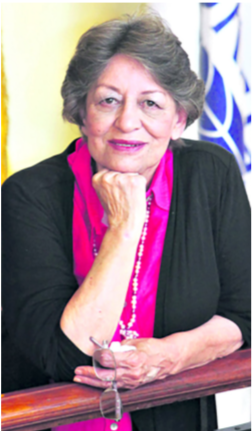
de Michigan State, donde fue candidata para el Ph.D.
Susana fue invitada como ejecutiva en residencia para enseñar en el Instituto de Tecnología de Georgia. Ella tiene un interés especial en la educación ambiental y es miembro de las juntas de dos ONG ambientales, así como en temas de la sociedad civil. Bajo su dirección, la Comisión ha ampliado el acceso al Programa Fulbright mediante un reclutamiento agresivo fuera de las ciudades principales y mediante la asignación estratégica de estudiantes con alto potencial a la escuela de inglés de la Comisión en el sitio. Obtuvo importantes fondos del Gobierno de Ecuador para ampliar el programa en 2006. En 2007, se ausentó de la Comisión para unirse al Gabinete del Presidente Correa, en calidad de Ministra de Producción. Regresó a la Comisión en mayo de 2009.
¿Nos cuesta identificar nuestras virtudes?
Uno se describe como quisiera ser, quizá no como es. Yo siempre digo que mis defectos son mis virtudes. Yo soy muy pegada a la familia. Yo crecí en un hogar diferente al común denominador en Ecuador. Mi mamá era gringa, hija de español nacida en Estados Unidos.
¿Cuáles son las lecciones de sus padres que le marcaron en la vida?
Mi mamá era muy exigente a nivel académico. Por ejemplo, de niñas no podíamos salir de la casa el sábado si no traducíamos el editorial de ese día del diario El Comercio. En realidad, no era un sacrificio. Me encantaba esa tarea. Mi mamá era profesora también
¿Y una lección del papá?
Cuando yo tenía 15 años, mi papá era diputado en el Senado. Y le comenté que necesitaba la cédula. Enseguida me dijo: mañana temprano te acompaño. Fuimos a la oficina del Registro Civil al centro. Me explicó a dónde debía dirigirme. Me dejó haciendo la fila de la calle Flores y me dijo: “si te da hambre hijita, comerás con esto”. Me entregó dinero y se fue. Mi padre jamás usó el poder para nada. Apenas tenía 15 años y con esa experiencia aprendí tanto del país que no conocía, aprendí sobre la discriminación. Había gente que estaba haciendo fila ya 4 días. Indígenas que habían dejado a sus hijos encerrados en la casa, en Cayambe. Personas que no recibían atención porque eran indígenas.
¿Quizá esta primera experiencia fue el motor para trabajar siempre vinculada al desarrollo humano?
Creo que sí. En mi hogar, por ejemplo, teníamos amigas judías. Muchos años después, fui a visitar a la mamá de una amiga y ella me dijo “fuiste la única amiga de mi hija”. Pensé que era una exageración, pero no. Entonces supe que la mamá de mi amiga había estado en un campo de concentración
¿Cuál era la religión de su familia?
Ninguna. No teníamos una religión de cabecera. Todos nacimos católicos pero mis padres no nos obligaban a ir a misa. Había un colegio que tenía un uniforme azul con una capa roja que me encantaba. Un día le dije a mi papá “quiero ir a ese colegio” solo por la capa. Y mi papá me respondió: “hija mía, en colegio de monjas, sobre mi cadáver”.
Entonces, nunca tuvo un dogma impuesto.
Yo soy creyente. Creo que hay una fuerza superior para la creación de todo.
¿Qué hay sobre el apellido?
Mi apellido es peculiar, hasta hoy la gente se ríe. No es un apellido común. Con el tiempo descubrí que el apellido viene de la batalla de Las Navas de Tolosa de 1210. Cuando alguien quiere insultarme, recuerdo el origen de mi apellido. Me siento bendecida por la fortaleza que me dieron mis padres desde el hogar. Mi papá y mi mamá siempre estaban juntos. Con todas las ocupaciones de mi papá, él nunca dejó de ir a los programas de colegio en que participábamos mis hermanas y yo. Mi papá aún vive. Tiene 97 años.
¿Si en el colegio participó en el club de periodismo, por qué no estudió esa carrera?
Una vez vino de visita una periodista estadounidense al colegio Americano que me dijo: jamás seas periodista. Y me descorazonó. No había muchas opciones para las mujeres, la mayoría seguía secretariado. En mi generación, promovimos que se cree la especialización de ciencias sociales porque no queríamos seguir secretariado. Pero no seguí periodismo, aunque sí me gusta la investigación. Seguí literatura.
Entrevista
Pero su trayectoria ha sido en negocios, ¿qué pasó con la literatura?
Nunca he hecho nada en literatura. Creo que debido al divorcio. ‘Mi difunto ex’, como yo le digo, estudiaba economía. Yo siempre le leía
sus trabajos, lo criticaba y me interesaba. Fuimos a vivir a Brasil porque se ganó una beca para sus estudios. Pero la beca no alcanzaba ni para comprar fréjol. Tuve que buscar trabajo pero no tenía ni contrato ni permiso para hacerlo. Y no descansé hasta conseguir el permiso tras plantarme en la oficina pública que los emitía. Entonces, me involucré como traductora con una empresa que representaba un banco pero allí también empecé a elaborar informes económicos porque los demás no sabían como hacerlo del portugués al inglés. En cualquier lugar en que he trabajado, nunca me ha gustado hacer quedar mal a la institución.
¿Qué relación encontró entre la literatura y la economía?
En ese trabajo me di cuenta del valor de la educación porque la relación está en el análisis, ese pensamiento analítico que uno desarrolla en la literatura se puede pasar a cualquier ámbito.
Después de una vida entera vinculada a la educación y al desarrollo, ¿qué cree que le falta por hacer?
Quiero aprender bien el alemán porque qué tal si Dios es mujer. Yo tengo algunos reclamos por hacer, por ejemplo por qué puso yuca en los países más pobres. Es un alimento que llena pero no nutre. Dejé de leer mucho tiempo. Ya no tengo televisión y he retomado la lectura. Eso es algo que ya empecé a hacer.
¿Qué agradece del divorcio?
Yo me casé con un norteamericano. Creí que no iba a tener actitudes latinas pero no fue la persona que apoyaba mi desarrollo. Él no cumplió con su palabra. Yo lo apoyé en sus estudios pero yo no pude terminar mi Ph.D en literatura. El divorcio es un duelo, es la muerte de una relación aunque ahora la sociedad quiere apurar las cosas. El divorcio hace la vida dura pero me enseñó a no depender. Eso también es malo porque yo me volví demasiado independiente y no quise saber de nadie más.
¿Cuál es el riesgo de ser muy independiente y perseverante?
Uno tiende a pelear. Yo peleo por los principios. Pero, inconscientemente, uno aleja a las personas que quizá pudieran haber sido otra pareja. Yo tuve un enamorado en el colegio y cuando me gané una beca para estudiar en Estados Unidos, un día me dijo que “me daba permiso para irme a estudiar”. ¿Cómo así? Las únicas personas que debían darme permiso eran mis padres. No es fácil relacionarse con una mujer independiente.
¿Cuál es su mayor satisfacción en el ámbito laboral?
Creo que he tenido una suerte increíble en la vida. Uno tiene que dar a los demás si ha nacido con ventajas en la vida. Cuando trabajé en una empresa textil, eran 1200 obreros, un día visité el comisariato y vi en la despensa fideos y papas, nada de proteína cuando la fábrica operaba 24 horas al día. Entonces, me involucré en la nutrición de los empleados. Hice los primeros cursos para mujeres aunque ellas estaban interesadas más en aprender decoración de pasteles.
¿Cómo fueron esos cursos?
Me di cuenta que el hombre recibía su sueldo, la mujer le rogaba que le dé para la comida si no se emborrachaba antes. Por eso, luego hicimos un curso de costura para las mujeres. Eso casi causa una huelga entre los obreros porque ellas empezaron a generar su propio ingreso y eso les dio independencia. Entonces obligué a los miembros del sindicato a tomar el curso para involucrarlos y cuando terminaban salían con diseños de ropa para sus hijos. Para mí ese es un gran logro, haber cambiado los esquemas, los paradigmas. Cuando se hizo el hotel Oro Verde en Quito, el ahora llamado Swissotel, ganamos un concurso para hacer la mantelería del hotel. Entramos a ese negocio no para ganar dinero sino para que nuestros obreros miren sus obras y reconozcan que son capaces de producir telas del primer mundo.
¿Quizá su vida personal ha quedado desplazada por dedicarse a los demás?
No lo creo. Yo quería estudiar ballet cuando era niña. Mi mamá me dio mil excusas para negarme esa posibilidad. Pero no quería quedarme con esas ganas. Cuando estuve en Brasil, me metí a estudiar ballet a los 30 y pico de años. Bailé, me presenté. Hice lo que en mi infancia no pude hacer.
Quizá una frustración más grande que tengo es que he dejado la música. Ya no tengo tiempo para tocar el piano. Hasta fui parte de un coro. He dejado el piano y el coro.
A todos nos falta tiempo, ¿cómo manejarlo?
Ahora no sé manejar el tiempo. Creo que antes lo dominaba mejor. La universidad te da la idea de que tienes libertad. Aunque sea mentira, hay esos espacios en que uno toma un café con un amigo, hay intercambio con la gente. Extraño mucho ese ambiente de la universidad.
¿Qué está haciendo para mejorar su manejo de tiempo?
En el 2017, me dio un patatús. Trato de no estresarme, de salir temprano del trabajo. Leo mucho.
¿Cómo no estresarse?
A mí me gusta el teatro. Cuando era soltera, iba sola a las obras porque ninguna de mis amigas quería ir porque tenía miedo. Somos una sociedad de miedos y no podemos dejarnos dominar por el miedo. Mucho del estrés que tenemos responde al miedo.
¿Cuáles han sido sus mayores dificultades?
Nunca he creído que exista algo que no pueda resolver. Recuerdo que cuando empecé a trabajar en la fábrica textil, era la primera mujer ejecutiva en esa empresa. A mí me había contratado el dueño de Estados Unidos que no pasaba en Ecuador. No me dieron oficina y nunca me asignaron una. Aproveché la renuncia de otro funcionario y ocupé su espacio. Los demás ejecutivos no hablaban conmigo. Mi función era diseñar planes de capacitación. Los jefes nunca fueron
groseros conmigo pero no me daban información. Así que iba a cada área para aprender cómo eran sus procesos.
¿Y la relación entre mujeres?
La peor enemiga de la mujer es la mujer. Muchas veces he escuchado denigrar el trabajo de una secretaria. Las mujeres no reconocen los méritos de las otras. Yo siempre he sido respetuosa de la gente. Pero nunca he llegado a entender esta actitud de competencia entre mujeres.
¿Cuál es su mayor arrepentimiento?
No creo tener uno en especial. Pero sí me molesta no haber terminado mi Ph.D. Yo iba a acabar y me dieron la opción de dar un examen y graduarme. Lo curioso es que tenía que justificar por qué salí del mundo académico, era como presentar una excusa de por qué dejé los hábitos de la academia. Y pensé que no tenía por qué pedir disculpas de lo que he hecho en mi vida. Entonces, no me gradué. Cuando estudiaba literatura, llegué a un punto de perder la delicia de leer porque uno identifica huellas de otros autores en cada escritor.
¿Hasta cuándo piensa trabajar?
Creo que ya estoy llegando a una etapa final en la comisión, uno o dos años más máximo. Cuando me llamó el presidente Rafael Correa a formar parte de su gabinete, estaba en un momento en que necesitaba hacer algo nuevo para no aburrirme. En ese tiempo, perdí gente muy valiosa. El equipo de Fulbright se desarmó. La Comisión ha sido líder en apoyar áreas que nadie más lo ha hecho. Fue la primera en apoyar medio ambiente cuando nadie hablaba de eso. Gracias a una beca Fulbright, Ecuador tuvo su primer abogado ambientalista. También fuimos pioneros en apoyar el cine.
¿Y luego qué piensa hacer?
Quiero retomar la música. Tal vez tome clases de pintura. Me gusta mucho la naturaleza. Buscaré algo en que pueda ayudar. Quisiera ser buena en matemáticas para ayudar en eso, para que el país mejore y podamos entrar verdaderamente al mundo del siglo XXI.
VICTORIA ISABEL CARRASCO TORAL
victoriaicarrasco@hotmail.com
DOI: HTTP://DX.DOI.ORG/10.24133/VINCULOSESPE.V3I2.1543

My time spent as a Fulbright Scholar was quite an experience. Learning about United States culture and sharing my Latin American roots with my American friends was a great adventure. I discovered that Eastern Kentucky is rich in Folk Art tradition. Wood carvings, weaving and spinning, painting, quilts, basket weaving, etc., all impressed me. I did not expect such a rich culture.
Even though this cultural exchange was challenging, I also found that people from Kentucky showed a great understanding and appreciation of my work. We share the fact that we both come from very strong, albeit different, traditions.
Latin-American Folk Art has many similarities with artistic expressions found in Eastern Kentucky. These include rich colors, shapes and meanings.
For example, I studied the work of Dennis Goodpaster, a native of Morehead, Kentucky who crafts walking sticks. I discovered that Mr. Goodpaster’s work was similar to many of the folk artists I have encountered all over the world. He embraces his natural environment and uses themes and bright colors from his everyday life in his work.
I also had the opportunity to work with Granny Toothman, a weaver who uses many types of natural fibers. We exchanged several ideas and techniques. However, the greatest positive cultural shock occurred while I was teaching Folk Art at Morehead State University (MSU). My students were very interested in my background, the origins of Latin American Culture and particularly, preColumbian and Inca influences.
My weaving classes were very special to me. The students were very enthusiastic, and I developed very positive relationships with them. They were very interested in using fibers, colors, textures and techniques. Even though they came from a different culture than my own, all of them were very open-minded and warm. Indeed, we found that we share common influences and backgrounds from which to build on. Overall, my teaching experience was grea
In addition to my students, there were several other people I worked with at MSU who were very instrumental in making my stay a very pleasant experience. Dr. Judy Rogers, Dean of Undergraduate Studies, helped coordinate my program. She was a smart and professional woman, who organized my program extremely well. She arranged my schedule and teaching duties and planned an exhibition of my artwork. She organized my visits to other universities and high schools in the area and introduced me to other artists who helped me in various ways. She made herself available to work with me whenever any difficulties arose and was very friendly and warm. She was essential in making my stay a tremendous success. Dr. Rogers’ secretary, Carolyn Hensley, was a tremendous help to me as well, always very friendly and willing to work with me. Dr. Roger Jones, a Professor of Art at MSU, also acted as coordinator of my program. Dr. Jones worked closely with me and became a liaison in scheduling my activities.
Two of the first friends I met in Morehead were Dr. Vicente and Sara Cano. They teach Spanish and invited me into their home and into their classrooms to speak about my culture. We not only developed a professional relationship but also became great friends.



wood and metal and assembly of my art project. I had to do it all by myself. In Ecuador, on the other hand, my assistants would have done all the groundwork. That was really an extraordinary and life-enriching experience as an artist and craftswoman.
I am grateful that the Fulbright Scholarship gave me the opportunity to share my culture and my work. I hope that showing Latin American Culture to the people of this region of the United States was of equal value to Morehead State University. I enjoyed the exchange of cultural art, education, and ideas. This was a very positive experience for me, as an educator and artist, as well as a human being.
I was lucky enough to get a second opportunity to teach and work in the US as a Fulbright Scholar at Oklahoma City Community College from 1998 to1999. My experience provided many opportunities for the exchange of ideas and cultural experiences. I feel that I gained a much greater understanding of North American culture as a result of my stay there. All the lectures were a learning experience for both my students and myself. Although there are many differences between the educational systems of the US and Ecuador, I shared with my colleagues the same goals of instilling a love for the arts and encouraging creativity.
In addition to the cultural and academic benefits of my stay, I had the opportunity to meet and get to know many people whose kindness and generosity enriched my experience in Oklahoma. I left behind many friends when I returned to Ecuador. I want to give special thanks to Dr. Robert Todd, President of Oklahoma City Community College; Dr. Paul Sechrist, Vice President for Academic Affairs; and Susan VanSchuyver, Acting Dean of Arts and Humanities. Several faculty colleagues organized events and provided guidance, support and friendship, in particular, Caroline Farris, Professor of Visual Arts; and Patricia J. Brooks and Dianne Broyles, Professors of Modern Languages. Other colleagues were also helpful and supportive: Abra Glenn-Allen Figueroa, Professor of English as a Second Language; Mary Ann Moore, Professor of Visual
Arts; and Dr. Richard Rouillard and Bertha Wise, Professors of English and Humanities. The office staff of the Division of Arts and Humanities, Sherry Hobbs and Rochelle Mosby, did far more than what was required in order to keep events running smoothly.
I had many contacts with the large community, including presentations at public and private high schools and colleges and visits to museums and galleries. I became acquainted with many local artists and had the opportunity to view their works and engage in discussions of the process of artistic creation. The Division of Arts and Humanities arranged an exhibit of my work at the Oklahoma City Community College library and the opening was attended by artists from the community as well as college faculty and students. There was much favorable response to my work, and several pieces were sold. In addition, I donated two large works, one to the college and the other to a medical facility. It is gratifying to know that after I left Oklahoma, many people would view these works and would respond to my creative efforts.

VICTORIA ISABEL CARRASCO TORAL
victoriaicarrasco@hotmail.com
Experiencia Profesional:
Educación:
Exposiciones:

HEATHER A. RULE
Architect, Austin, Texas, USA
heather.a.rule@gmail.com
DOI: HTTP://DX.DOI.ORG/10.24133/VINCULOSESPE.V3I2.1546
RESUMEN
Una de las misiones de Fulbright es el intercambio cultural. Entender y ser entendido mediante el intercambio de experiencias y conocimiento es esencial para tener empatía entre naciones y personas. El ensayo que sigue es una reflexión del impacto y los aprendizajes de una becaria de investigación del programa Fulbright US Student durante la estancia en Ecuador entre 2016-2017. El trabajar con mujeres en fincas florícolas ecuatorianas, contribuyó al entendimiento del ambiente construido y las condiciones de las mujeres. Los aprendizajes y el impacto personal de la experiencia de Fulbright fue mucho más allá que el proyecto de investigación.
Palabras Clave:
Intercambio cultural, experiencia Fulbright, mujeres, feminismo, industria florícola
ABSTRACT
Cultural exchange is the basis of the Fulbright mission. To understand and be understood through the exchange of experiences and knowledge is essential to creating empathy between nations and people. The following is a reflection on the impact and lessons of a Fulbright US Student research grantee during her time in Ecuador in 2016-2017. Her research with women working on flower farms in the highlands of Ecuador led her to new understandings of the built environment and conditions of women. The lessons learned and the personal impact of the Fulbright experience went beyond that of a research project.
Key Words:
cultural exchange, Fulbright experience, women, feminism, flower industry.
INTRODUCTION
“Your project will change” I was told the first day I checked in at the Fulbright Commission in Quito, Ecuador. My immediate reaction was resistance, after all, was it not my research proposal that got me accepted? I had submitted a proposal that had considered all the factors, or so I thought. Over the course of the next ten months I would realize just how true that initial statement was and would appreciate being prepared for the inevitable adjustments to my research process. This lesson was valuable, both in the flexibility with which I learned to pursue my research and in how I kept an open mind as I worked with the women that participated in the research. It
prepared me to learn about the Ecuadorian culture and customs with an unrestricted perspective. These are the types of lessons we gain from a cultural exchange that make programs like Fulbright essential to creating empathy and understanding between cultures and people.
Choosing Women in the Flower Industry
My research proposed studying the agency of women in the rural built environment of Ecuador. Working specifically with women in the flower industry, I wanted to understand how the economic impact of receiving salaries for their employment at flower farms had an influence and/or
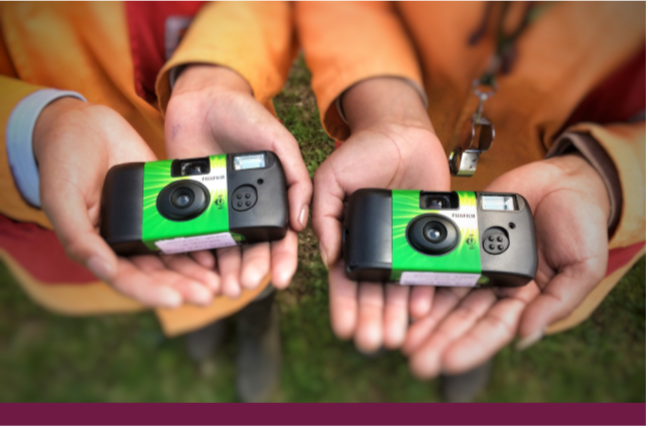 Image1.Disposable cameras used by women to document their built environments. Photo taken by Heather Rule. 2017.
Image1.Disposable cameras used by women to document their built environments. Photo taken by Heather Rule. 2017.
effect on the homes and communities they lived in. The flower industry in Ecuador has impacted the agrarian land use and the livelihoods of women in the Cayambe region since its growth began in the 1980’s (Becker, 2009). According to the statistics kept by Expoflores, the National Association of Producers and Exporters of Flowers of Ecuador, women currently represent 51% of the workers in the industry. Being an industry that is mainly located in rural areas this has a direct impact on the livelihoods of women.
As an architect, I am interested in how people affect the built environment they live and work in and in turn how that built
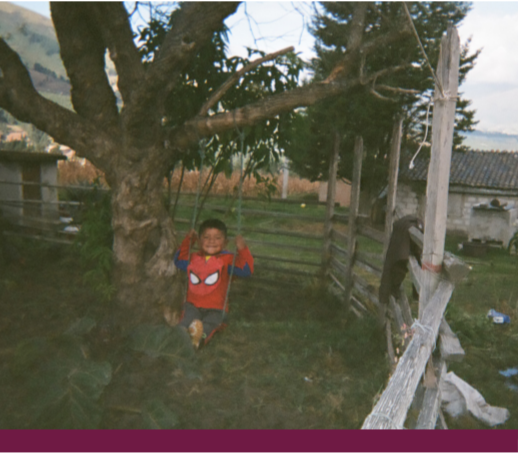
environment effects them. For this research, the built environment can be defined as any physical place that is used or manipulated by people. As a woman and feminist, I am specifically interested in these topics from a gendered perspective.
In my grant application I proposed using participatory design methods to map women’s lives in their homes, communities and work places. One of the lessons I had to learn early on was that the first step to a research project with human subjects is building relationships. My proposed methods and approach needed to be reevaluated. I started collaborating with people in the flower industry to build an understanding of the history and present state of challenges within the industry. This process allowed me to build relationships and opened my eyes to perspectives I had not previously considered.
Recognizing that the perspective of others is more valuable than my interpretation of their lives, I adjusted my research methods. Using disposable cameras and a list of provocations I worked with twenty women on four rose farms to document their homes, communities and work spaces. These adjustments did not mean I had to drop my pursuit of understanding the agency of women in the built environment. Instead I had to change the methods I used to research and document these interests in a way that was responsive to the culture I was living in and the women I was working with.
Seeing through a different lens
In the past, the flower industry in Ecuador battled issues of child labor. As a result, campaigns and programs were implemented to raise
Image2.Young boy on homemade swing in the chakra. Photo taken by Maria Celia Llenera Cuascota. 2017.
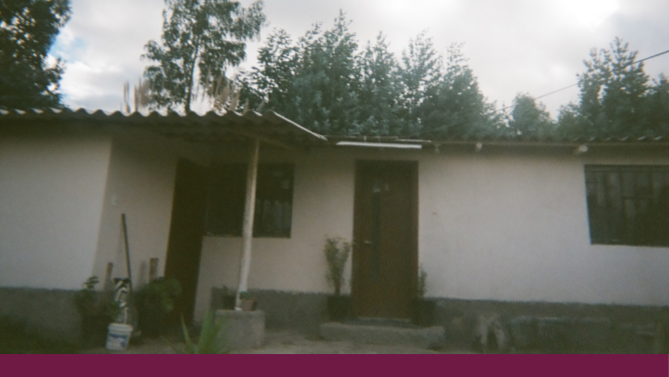
Image 3. “The house I built.” Photo taken by Susana. 2017
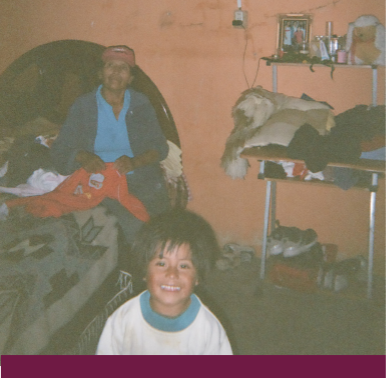
Image 4. “A home for my children.” Photo taken by Liliana Guaman. 2017
awareness and end child labor within the industry. My collaboration with the area of social responsibility at Expoflores opened my eyes to the impact the projects they executed over the last several years could have on the lives of families, especially women and their relationship with their children. Through the projects they carried out they went beyond just ending child labor and into developing an understanding from both the employers and employees that children must remain in school and there were other alternatives for economic development for families. These changes are evident in the ways in which the mothers that work on flower farms speak of the importance of keeping their children in school as a way to build a better future for them.
Their built environments also show evidence of the impact these programs have had on families. Maria Celia, one of the women who participated in the camera project, shows this impact in the photo she took of her son enjoying the homemade swing installed on a tree in their chakra (the family garden). In a small, yet significant way, this photo is the visual representation of these processes that have eliminated child labor and empowered women. This image touched my heart. A swing is one of those life pleasures I enjoy and that takes me back to memories of my own childhood. Feelings of freedom and joy are captured in the ungrounded motion of swinging. This photo reminded me that we share as many similarities as we have differences between people and cultures.
Changing my Perspective
Two writings I was exposed to during my graduate studies had an influence on how I question and think of the conditions of women and the built environment. In her research about kitchen spaces, Maria Elisa Christie (2006), questioned the typical feminist dialogue of kitchens as spaces of oppression of women and argued that women in central Mexico found these to be spaces of empowerment. Friedman (1992) presents the case for the role culture plays in gender and in understanding gender roles. History and research about women generally shows us that women are more likely to invest their money in ways that benefits their children and family. I was interested in further understanding how this related to their investment in the built environment. Did they build or change their homes as a result of having an income? Did they become more involved in the development of spaces in their communities? While these questions are the basis of research I hope to share in another forum, it was the lessons I learned from how these women, directly and indirectly, answered them that had a profound impact on changing my perspective.
Having employment on rose farms, where they are receiving their own money allows them to build savings and to access credit on their own. They use their income to build a better future for their children. This is consistent with what we know about how women spend money. What I learned from these women is that it is not enough to just provide education and a house for your children. Their economic independence has allowed women in abusive relationships to leave their partners because they are no longer dependent on them to provide a home for their children. For many of them, a reason for leaving violent partners was to create a safe place for their children. They have realized that raising children in a non-violent environment is vital to breaking the cycles of gender violence.
CONCLUSION
In the end my project changed, but more pointedly I changed. I return to the United States with a transformed perspective. The women I worked with and the people that became a part of my life in Ecuador gifted me with new questions and outlooks. They became my friends, collaborators and mentors.
I was based in the capital city of Quito, due to my academic and host organizations locations, but I travelled frequently to the more rural areas of Cayambe-Tabacundo and Lasso to work with women on flower farms. This gave me the opportunity to witness both the urban and rural contexts of life for women in Ecuador. Being simultaneously embedded in a range of conditions exposed me to the spectrum within the waves of feminism that are currently present in Ecuador. It made me realize it is a disservice to generalize the present or past context of a culture from a whole country perspective.
The most succinct way to summarize the impact of this cultural exchange can be shared in an anecdote. One of the women I had the honor of collaborating with at Expoflores looked at me one day and said “you are the first person from the United States that I have liked.” This was a defining moment because I realized we unfairly judge other cultures based on our limited exposure to the people that represent them. It was that moment where I realized that my research, the reason I supposedly had come to Ecuador, was secondary to the cultural exchange element of Fulbright grants. While I believe that my research can contribute to advancing the conditions of women, I also learned that the personal relationships I built came first and had the greatest impact.
ACKNOWLEDGEMENTS
My time in Ecuador was funded by a Fulbright US Student Research grant. The backing received from the Fulbright Commission in Ecuador, especially from Susana Cabeza de Vaca and Karen Aguilar, and the US Embassy in Quito was instrumental. Having my fellow Fulbright grantees as a research sounding board and support system made the grant year a transformative experience.
I am grateful for the advice received from Professor Michael Hill, Ph.D. at the Universidad San Francisco de Quito whose insights were influential to my research. Within the flower industry I received support from Expoflores, Royal Flowers, BellaRosa, and Quito Inor Flowers, the farms that allowed me to connect with the women working in their organizations. Finally, I must thank my family for their support and especially my father Dean Rule for the connections he established within the flower industry that were essential to my research.
REFERENCES
Becker, Marc y Silvia Tutillo. 2009. Historia Agraria y Social de Cayambe. Quito: FLACSO, Sede Ecuador : Ediciones Abya Yala : 233-241
Friedman, John. 1992. Empowerment: The Politics of Alternative Development. Cambridge: Blackwell : 107-126.
Christie, Maria Elisa. 2006. Kitchenspace: Gendered territory in central Mexico. Gender, Place and Culture 13(6): 653-661
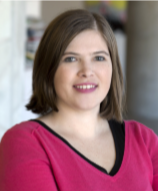
HEATHER A RULE
heather.a.rule@gmail.co
Heather Rule is a licensed architect who combines research, design and advocacy. She is a passionate advocate of women’s rights and equitable environments through research. Her education includes a Bachelor of Science in Architecture from the University of Michigan in Ann Arbor. She received a Master of Architecture from the University of Texas at Austin and was the first student to pursue and receive the Latin American Architecture Certificate. During this time her research began to focus on the conditions of women in the built environment with a focus on South America. Her professional experience encompasses healthcare, institutional and commercial projects around the United States. She received and completed a Fulbright US Student Researcher grant to study the agency of women in the built environment of rural Ecuador.
Crnl. E.M.C. HUGO RUIZ VILLACRÉS, PH.D.
Universidad de las Fuerzas Armadas ESPE, Av. General Rumiñahui s/n y Ambato, Sangolquí - Ecuador
hdruiz@espe.edu.ec
DOI: HTTP://DX.DOI.ORG/10.24133/VINCULOSESPE.V3I2.1547
Varios autores e investigadores en este campo consideran que el fortalecimiento y afinamiento de los sistemas de innovación regionales y nacionales es una importante estrategia para influir positivamente en el crecimiento económico y consecuentemente elevar los estándares de vida de sus habitantes y de la sociedad en general. Debido a sus beneficios económicos incuestionables existe una carrera permanente entre los países que generan tecnología de vanguardia, para llegar primeros a los mercados globales con productos innovadores. Cada vez son más los gobiernos que intentan unirse a la estrategia de impulsar su crecimiento económico mediante la comercialización de nuevos productos tecnológicos resultantes del los procesos de investigación científica, lo que se conoce como economía basada en el conocimiento.
Países de Asia, entre otros en el resto del mundo, han invertido de forma sostenida en el desarrollo de sus sistemas de innovación tecnológica, en la modernización y actualización de las instituciones dedicadas a la investigación, destinan más fondos para fortalecer los
procesos de investigación científica con la intención de que estas iniciativas impulsen el crecimiento de los sectores industriales, aceleren la sofisticación de sus procesos de manufactura, atraigan inversión extranjera directa y como resultado establezcan en el mediano plazo los cimientos para una economía basada en el conocimiento.
Estos países dedican esfuerzos para mejorar la colaboración entre la industria y la universidad, establecen un marco legal adecuado que fomente el respeto a los derechos de propiedad intelectual, que inspire la confianza y tranquilidad a los inversionistas foráneos, creando estructuras institucionales complejas e interrelacionadas que impulsen el emprendimiento y les tornen más competitivos en los mercados globalizados.
La pregunta que necesariamente deben hacerse los países que optan por esta estrategia es: ¿cuáles son los factores básicos que deben estar presentes en un ecosistema para que el proceso de innovación científica tenga éxito? La respuesta no es sencilla y de hecho no
existe una sola respuesta, todo depende: En primer lugar del entorno y de las condiciones circundantes en cada caso, pero cuando se habla de ecosistemas de innovación, existen aquellos factores que deben estar presentes obligatoriamente, independientemente de las características geográficas o de diferencias políticas e ideológicas.
Un ecosistema de innovación científica y tecnológica debe contar con varios factores que obligatoriamente deben coexistir y en las proporciones adecuadas para contribuir con el equilibrio del sistema, de ahí el nombre de ecosistema. La falta o exceso de uno, provocaría un desbalance que puede resultar perjudicial para otro u otros componentes funcionales del sistema. Por el contrario, estos elementos al estar presentes y correctamente balanceados, van a permitir que las ideas y nuevos descubrimientos, sea que provengan de procesos de investigación en las industrias del sector privado o de los resultados del trabajo científico en los laboratorios de las universidades, completen el ciclo de innovación y terminen con productos que se comercialicen y sean adquiridos por una sociedad que genera demanda, que exige cada vez mejores productos, más modernos, que mejoren su calidad de vida y aumenten su comodidad y satisfacción.
A este proceso innovativo, Joseph Schumpeter lo definió como “la destrucción creativa”. De acuerdo a Schumpeter, la innovación es el desplazamiento o suplantación de los productos que la sociedad está consumiendo actualmente, por otros, concebidos como resultado del dominio y desarrollo de nuevo conocimiento, de tecnologías disruptivas, con mejores características de durabilidad, métodos de fabricación, precio o calidad y que en consecuencia superan a sus antecesores, haciendo que sean adoptados rápidamente por los
consumidores, causando como consecuencia inevitable que los productos de tecnología obsoleta, agoten su demanda y salgan del mercado, ocasionando su fin o destrucción, por efecto de la creatividad científica.
El mundo está cada vez más expuesto a la competencia tecnológica, lo que se evidencia en la implementación de políticas públicas que impulsan la innovación, tales como el desarrollo de las capacidades e incentivos para las pequeñas y medianas empresas, la asignación de mayores presupuestos nacionales destinados para la investigación y el desarrollo, el fortalecimiento de los sistemas de educación superior y la modernización y mejoramiento de institutos públicos de investigación.
Gobiernos como los de Francia, Gran Bretaña, Finlandia, Holanda, Estados Unidos, China, Korea del Sur y Japón, por mencionar solo algunos, incentivan y posibilitan la creación de clusters tecnológicos donde se agrupen empresas e industrias afines con una meta común: el desarrollo y la comercialización de nuevas tecnologías. Históricamente se ha evidenciado que los resultados de estas iniciativas no son visibles de inmediato, sino que son iniciativas que maduran en el mediano y largo plazo, luego de que han pasado décadas desde su implementación, por lo que existen dudas sobre la efectividad que tendrían estas iniciativas, si son adoptadas e implementadas por otros países del mundo.
Dentro de los sistemas de innovación regionales y nacionales exitosos se evidencia que la incubación de empresas con tecnologías emergentes, se constituyen en generadores de plazas de trabajo y son catalizadores del crecimiento económico. Muchos estudios se han realizado acerca de cuáles son los factores que favorecen la
innovación científica y tecnológica, pero siendo un proceso complejo, el éxito no sucede espontáneamente. No son suficiente los factores elementales y básicos, se require también de su interacción apropiada y coordinada para que los resultados afloren.
Los investigadores que han intentado definir cuales serían aquellos factores que favorecen y posibilitan la innovación tecnológica se han enfocado en su gran mayoría a buscar los resultados de modelos de innovación en los países desarrollados: Estados Unidos, Alemania, Bélgica, Reino Unido, España, y varios otros países tanto de Asia como de Europa, muchos de los datos estadísticos que existen para poder evaluar estos sistemas, se refieren a los países miembros de la OECD. Lamentablemente, muy pocos estudios hacen referencia a los resultados de estas iniciativas de innovación tecnológica en países en vías de desarrollo, sea porque el número de proyectos es limitado o porque los resultados de estas iniciativas aún no se han hecho evidentes y por lo tanto cuantificables.
Con excepción de la China e India, y pocos casos de Brazil, Chile y México, la efectividad de estos procesos y su aplicabilidad para los países en vías de desarrollo, todavía es incierta, los resultados no se concretan, por tratarse de procesos que tardan en arraigarse y consolidarse, y que por lo tanto demandan varios años en rendir sus frutos.
No se tenía evidencia contundente acerca de cuales serían las implicaciones para una nación en vías de desarrollo dispuesta a incursionar y seguir por el camino de la economía basada en el
conocimiento, ¿qué factores deben de tomarse en cuenta como mínimo para arrancar?, ¿cuáles son las condiciones básicas para garantizar que los resultados de las ingentes inversiones nacionales sean prometedoras?. ¿Podría el éxito, que hasta hoy ha sido un privilegio solamente de los países desarrollados, trasladarse a los países que emprenden con estas iniciativas en otras regiones del mundo? La intención es tratar de emular el éxito de Silicon Valley, localmente. La brecha tecnológica entre los países que innovan y los que han tardado en adoptar estas estrategias de emprendimiento tecnológico se sigue ampliando y como consecuencia inevitable, también la brecha económica y de la calidad de vida de sus habitantes.
Hay incertidumbre en los países en desarrollo acerca de los componentes básicos necesarios y otros factores que se necesitan tener en marcha de modo que estas inversiones nacionales traigan resultados favorables. Las lecciones aprendidas y enseñanzas de países exitosos que cuentan con una considerable experiencia en la implementación y el crecimiento de sus sistemas de innovación tecnológica, bien podrían ser aplicables a nuevas iniciativas en otros países, que recién incursionan en esta estrategia.
Es importante conocer cuales son estos componentes básicos, que sin importar la ubicación geográfica, cultura, o tendencia política, son comunes y básicos para todos, además de como éstos están interrelacionados. Esta información, va a permitir que los planificadores, gobernantes e impulsadores de nuevos proyectos comprendan el proceso de innovación tecnológica en su contexto y tomen los pasos necesarios y correctos cuando diseñen o implementen nuevos sistemas de innovación.
Los países que quieren dar el giro de la economía tradicional basada en la disponibilidad y explotación de recursos naturales hacia la economía del conocimiento que proviene de los resultados de la investigación científica, deben tener especificidades o condiciones de partida que han de implementarse antes de importar iniciativas tecnológicas del mundo desarrollado. Existen características propias, que podrían ser decisivas y que pueden permitir o no, que estos nuevos proyectos maduren para que sean eficientes y efectivos.
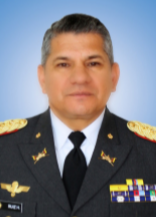 El coronel HUGO RUIZ VILLACRÉS obtuvo su Ph.D en Tecnología en Purdue University en los Estados Unidos de Norteamérica; es Ingeniero mecánico de la Escuela Politécnica del Ejército; además, ha realizado estudios de posgrado en Middle Tennessee State University y en State University of New York at Buffalo. Recibió la beca Fulbright en el Faculty Development Program año 2010.
El coronel HUGO RUIZ VILLACRÉS obtuvo su Ph.D en Tecnología en Purdue University en los Estados Unidos de Norteamérica; es Ingeniero mecánico de la Escuela Politécnica del Ejército; además, ha realizado estudios de posgrado en Middle Tennessee State University y en State University of New York at Buffalo. Recibió la beca Fulbright en el Faculty Development Program año 2010.
Su formación doctoral le permite la propuesta y administración de proyectos de investigación científica de gran escala, tanto en el sector público como privado, y en el diseño y ejecución de proyectos de investigación con una aproximación tanto cuantitativa, como cualitativa o dual. Los cursos de formación de posgrado más relevantes son Robotics, Production Systems Engineering, Computer Integrated Manufacturing, Qualitative Research, Research Design, Nanotechnology.
Sus temas de interés en el campo de la investigación son el desarrollo tecnológico desde un enfoque multidisciplinario y un particular interés en la intersección entre la innovación científica y el desarrollo tanto local, regional y nacional. Ha sido expositor en varios congresos internacionales, y docente de diversas asignaturas. Ha ocupado varios cargos en la ESPE, los más relevantes: director del Centro de Mecatrónica, decano de Ingeniería Mecánica, director de la ESPE Latacunga, vicerrector de Docencia, y el último cargo desempeñado es el de vicerrector Académico General. Actualmente, tiene el grado de coronel y ocupa el cargo de director de Comunicación Social del Ejército Ecuatoriano.
PABLO CAIZA SÁNCHEZ
Universidad de las Fuerzas Armadas ESPE, Av. General Rumiñahui s/n y Ambato, Sangolquí - Ecuador
hdruiz@espe.edu.ec
DOI: HTTP://DX.DOI.ORG/10.24133/VINCULOSESPE.V3I2.1548
INTRODUCCIÓN
Obtuve una beca Fulbright en el año 2007, lo que constituyó el impulso inicial para finalmente alcanzar en el año 2012 el grado de PhD en Ingeniería Civil de la Universidad de Illinois en Urbana-Champaign. Fueron años de retos cumplidos que me sumergieron en un mundo de avance tecnológico. Una de las estrategias para no ahogarme, para superar mis limitaciones, enfrentar y dominar las innumerables exigencias de mis estudios, fue abrir mi mente a los cambios. En efecto, era evidente que mi cerebro filtraba la información que recibía y sólo aceptaba la que se acomodaba a patrones establecidos por los años de experiencia y vida. Pero los nuevos conocimientos eran tan diferentes, que necesité generar también nuevos patrones de aprendizaje, o fracasar en mis estudios y mis sueños.
El sismo de 16 de abril de 2016, también ha puesto a los ingenieros estructurales ecuatorianos frente a la realidad de que las formas tradicionales de construcción producen daño excesivo y que por tanto hay necesidad de nuevas técnicas que permitan controlar este daño
de mejor forma. La Figura 1 muestra daño en mamposterías por fuerzas excesivas y también en elementos no estructurales por aceleraciones muy altas que producen su caída.
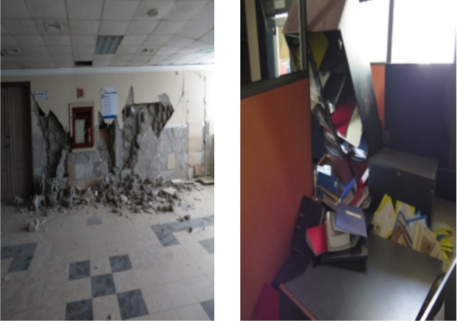
Figura 1. Daño en mamposterías y elementos no estructurales
SISMOS RECIENTES Y EFECTO SOBRE LAS CONSTRUCCIONE
Ya el sismo de 1998 de Bahía de Caráquez puso en evidencia defectos tales como estructuras aporticadas excesivamente flexibles y mamposterías pesadas y frágiles que sufrían mucho daño. Los mejores ingenieros estructurales de nuestro país enfrentaron el reforzamiento de las edificaciones dañadas mediante encamisados importantes no tan solo de las columnas sino de las vigas y con el empleo de mejores materiales y mano de obra para las mamposterías. Se logró, en efecto, reducir notablemente los desplazamientos horizontales de las estructuras y por tanto se pensó que también los daños en las mamposterías. Sin embargo, el sismo de 16 de abril de 2016, volvió a producir los mismos daños ya observados en el sismo de Bahía y en los mismos sitios. La conclusión a la que se llega es que no hay forma, a costos razonables, de que las estructuras aporticadas tradicionales se comporten adecuadamente ante las cargas sísmicas. Es necesario generar nuevos patrones de construcción con elementos relativamente nuevos en nuestro medio.
ALTERNATIVAS: MUROS ESTRUCTURALES Y SISTEMAS DE AISLACIÓN SÍSMICA
Una primera alternativa para reducir daños son los muros estructurales como complemento de los pórticos.
Pero usar muros implica ubicarlos adecuadamente para evitar torsión en planta, es decir hacia el centro de las plantas de las edificaciones. Implica que para reducir costos, se construyan pórticos sismorresistentes sólo en el perímetro de dichas plantas, y que por tanto las cargas verticales hacia el interior sean absorbidas por columnas conectadas
directamente a las losas de piso. Implica también que estas losas deben funcionar como diafragmas y que por tanto necesitan ser macizas. Es decir se trata de un cambio radical con la forma tradicional de construcción mediante sistemas aporticados. La Figura 2 ilustra algunas de las ideas anteriores con un gráfico obtenido del código norteamericano ACI 318S-14.
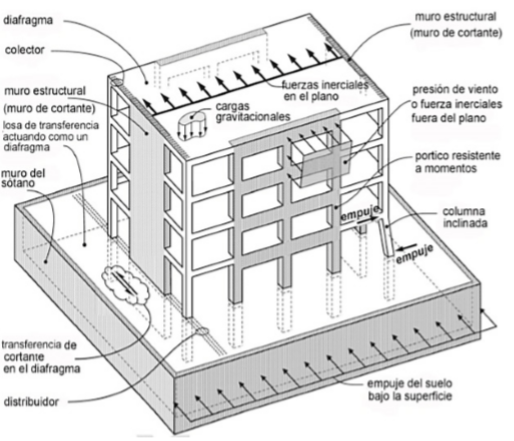
Figura 2.Edificaciones sismorresistentes (Fuente: ACI 318S-14)
Pero no tan sólo esto, vale la pena cuestionarse ¿por qué enfrentar al sismo aceptando daño aunque sea controlado? ¿Por qué no, de la misma forma que un torero hace el quite a un toro, hacerlo pasar
sin que dañe una estructura? En efecto ya existe la tecnología, por medio de aisladores sísmicos, que absorben el impacto sísmico, evitan grandes deformaciones y por tanto daño.
Afortunadamente, la Universidad de las Fuerzas Armadas ESPE está usando esta tecnología en su Nuevo Centro de Investigaciones Científicas. Debajo de cada una de las columnas de la estructura metálica se ha colocado un aislador de triple péndulo cuyas dimensiones se indican en la Figura 3.
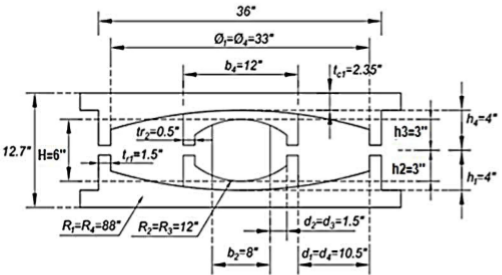
Figura 3. Geometría del aislador de triple péndulo
Este tipo de aislador resiste las cargas laterales por fricción, pero cuando estas se superan, su cuerpo interior se desplaza y se ve obligado a subir por una superficie cóncava, por lo que el mismo peso de la estructura lo empuja de nuevo a la posición inicial. Lo importante es que las deformaciones en la estructura son relativamente pequeñas y como ya se ha indicado el daño es relativamente leve. La Figura 4 muestra un aislador colocado ya bajo una columna metálica y una vista del avance de la construcción.
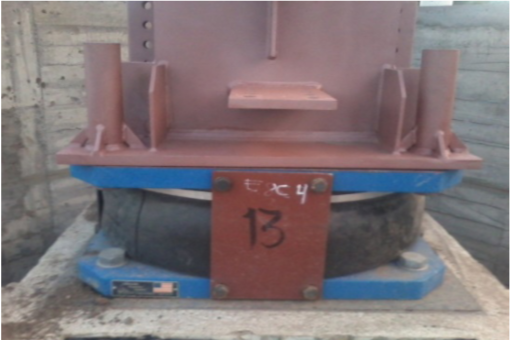
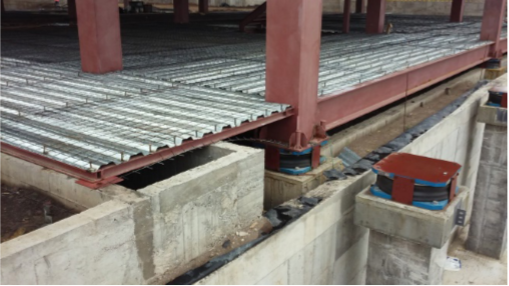
Figura 4. Aisladores sísmicos en el Nuevo Centro de Investigaciones Científicas ESPE
CONCLUSIONES
El sismo de 16 de abril de 2016 ha mostrado la necesidad de cambiar los sistemas constructivos tradicionales. Pero las alternativas ya existen y en este artículo se han indicado dos: sistemas duales, es decir pórticos complementados con muros y, sistemas de aislamiento sísmico tales como los de triple péndulo.
Para finalizar, ¿cómo lograr que este sistema constructivo se generalice? Un papel fundamental lo cumple la enseñanza en los cursos regulares de ingeniería civil de las características de este sistema, pues posteriormente los nuevos ingenieros lo difundirán en sus empresas y trabajos.
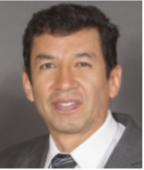 PABLO CAIZA SÁNCHEZ
PABLO CAIZA SÁNCHEZ
Obtuvo su PhD en Ingeniería Civil en la Universidad de Illinois en Urbana- Champaign en el año 2012. Allí fue primero becario Fulbright y luego Asistente de Investigación, siendo además Asistente de Docencia en varios cursos de estructuras. Tomó asignaturas tales como Hormigón Armado II, Estructuras de Acero II, Hormigón Presforzado, Métodos con Elementos Finitos, Mecánica Estructural, Dinámica Estructural, Ingeniería Sísmica, Análisis de Riesgos y Toma de Decisiones, Cimentaciones Profundas, Optimización Estructural, Hormigón, Madera, Acero.
Previamente obtuvo su M.Sc. en Estructuras en la Escuela Politécnica Nacional de Quito, y fue el mejor graduado de Ingeniería Civil en la Escuela Politécnica del Ejército (ESPE). También realizó cursos de posgrado en la Middle Tennessee State University en los Estados Unidos de Norteamérica, y en la Fachhochschule Hildesheim-Holzminden en Alemania.
Sus principales temas de investigación son: el análisis y diseño de estructuras con diferentes sistemas resistentes a cargas sísmicas, comportamiento no lineal de estructuras, monitoreo estructural, sistemas de aislamiento y de disipación de energía, interacción suelo-estructura considerando fenómenos tales como licuefacción y radiación de energía a través del suelo.
Actualmente trabaja en la Universidad de las Fuerzas Armadas ESPE.
JORGE LUIS SANTAMARIA CARRERA
Universidad Central del Ecuador, Ciudadela Universitaria, Quito - Ecuador
jsantamaria@uce.edu.ec
DOI: HTTP://DX.DOI.ORG/10.24133/VINCULOSESPE.V3I2.1549
ABSTRACT
Artificial neural networks (ANN) have been traditionally utilized for developing prediction models based on experimental data; however, fuzzy logic theory is a novel tool that could also be applied as well in this cases. The present study compares the performance of two different approaches; namely, ANN and fuzzy inference systems (FIS) for predicting concrete compressive strength. Adaptive neuro fuzzy inference systems (ANFIS) was the technique based on input – output experimental data that was used to create two Sugeno type fuzzy models for estimating concrete compressive strength and then compared with several ANN prediction models created through different methods. Subtractive clustering method was the clustering procedure for establishing the number of membership functions and fuzzy rules. Predicted data resulting from all models were presented in a comparative manner and validation analyses were conducted in order to observe the performance of ANN and ANFIS. The results indicate that both fuzzy models performed very well when estimating concrete compressive strength (i.e., all R2 values are greater than 90%) while for ANN, only one ANN method had an R2 value greater than 90%.
Keywords: Compressive strength, Concrete, Fuzzy logic, Neural networks, Prediction models
RESUMEN
Las redes neuronales artificiales (ANN) han sido tradicionalmente utilizadas para desarrollar modelos de predicción basados en datos experimentales; sin embargo, la teoría de lógica difusa es una herramienta que podría ser aplicada en estos casos. El presente estudio compara el desempeño de los dos enfoques; ANN y los sistemas de inferencia lógicos (FISs) para predecir el esfuerzo de compresión del hormigón. ANFIS (“Adaptive neuro fuzzy inference systems”) fue la técnica basada en datos experimentales entrada – salida que fue utilizada para crear dos FISs del tipo Sugeno para estimar el esfuerzo de compresión del hormigón y luego compararlos con varios modelos de ANN creados usando diferentes métodos. Los datos estimados resultantes de todos los modelos fueron presentados de una manera comparativa y análisis de validación fueron realizados para observar el desempeño de ANN y ANFIS. Los resultados indican que ambos modelos difusos tienen un muy buen desempeño cuando predicen el esfuerzo de compresión del hormigón (valores de R2 mayores a 90%) mientras para ANN, solamente un modelo tuvo un valor de R2 mayor a 90%.
Palabras Clave: Esfuerzo de compresión, Hormigón, Lógica difusa, Redes neuronales, Modelos de predicción
INTRODUCTION
Several studies have been done to develop prediction models for estimating concrete compressive strength using experimental data through artificial neural networks (ANN). For instance, Kim et al. (2004) applied ANN for estimating concrete compressive strength based on mix proportions by using the results of 28-day uniaxial concrete compressive test results, concluding that ANN are very effective. Also, Kostic & Vasovic (2015) succeeded in creating three ANN models with different learning algorithms and six number of hidden nodes for estimating concrete compressive strength by using different water – cement ratios, age of testing and freeze and thaw cycles. However, fuzzy set theory, a novel theory, is being explored for predicting new observations based on experimental input – output data. This study utilizes fuzzy set theory to develop prediction models for estimating concrete compressive strength using experimental data through adaptive neuro fuzzy inference systems (ANFIS) and compares the performance of neural network-based models with fuzzy inference systems (FISs).
An experimenter or analyst usually uses experimental data obtained through testing to model or predict results when dealing with complex systems, and FISs may be applied in these cases (Ross, 2010). Some methods are available to develop both membership functions (MFs) and if – then rules while others work with predetermined rules in order to model a system. Passino & Yurkovich (1998) mentioned several techniques for fuzzy identification and estimation including Batch Least Squares (BLS), Recursive Least Squares (RLS), Learning from Example (LFE), Gradient Method (GM), Modified Learning from Example (MLFE), and Clustering Method (CM).
Nevertheless, the aforementioned methods or techniques for creating MFs and fuzzy rules (i.e., if-then rules) are not the only ones available nowadays. Jang (1993) proposed a method called Adapted-Network-Based Fuzzy Inference System (ANFIS) for constructing a FIS by developing if – then rules and MFs based on input – output data tuples. ANFIS is a neuro-fuzzy model that utilizes the advantages
of artificial neural networks by allowing fuzzy systems to learn through a hybrid learning algorithm (Jang et al.,1997).
Subtractive clustering method (Chiu, 1994) is a very fast and efficient clustering one-pass procedure algorithm that does not involve any iterative nonlinear optimization. It works well for partitioning the input space (i.e., experimental data) in order to find the initial structure of a fuzzy inference system that will be used by ANFIS. The number of cluster centers identified became the number of MFs and if – then rules.
Kostic & Vasovic (2015) developed three neural network-based models based on experimental data for predicting concrete compressive strength by using different learning algorithms (i.e., Levenberg–Marquardt, scaled conjugate gradient, one-step-secant back-propagation), and such data and results will be used for developing two Sugeno type fuzzy models and studying their performance when predicting new observations. In other words, two different approaches will be evaluated: (1) ANN and (2) FISs developed through ANFIS. The main goal of this study is to analyze and compare the performance of ANN models and FISs for estimating concrete compressive strength based on experimental data.
FUZZY MODELING
Yager & Filev (1994a) pointed out that there are two approaches for developing fuzzy models; namely, direct approach and system identification. The first one consists of creating fuzzy inference systems based on experts’ knowledge. For instance, an expert is in charge of partitioning the data, creating if – then rules, choosing an appropriate reasoning method and evaluating the model.
On the other hand, system identification is a method for developing a fuzzy model based on input – output data (e.g., experimental data), and this approach results in developing a Sugeno FIS. System identification can be divided into: (1) structure identification and (2) parameter identification (Sugeno & Yasukawa, 1993).
The main goal of structure identification is to determine the partitions of the input and output data points, if – then rules and the number of rules. Parameter identification involves adjusting the parameters of the model so that output errors are minimized. In this case ANFIS will be used for parameter identification which takes advantage of neural networks and fuzzy set theory.
System identification
Structure Identification
There are several methods for clustering (i.e., classifying data) such as fuzzy C means. This method is a very popular method proposed by Bezdek (1981) and is based on iterative optimization. The objective function is intended to minimize Euclidean distances between a data point a its cluster center and to maximize the Euclidean distance between cluster centers (Ross, 2010). Mountain method, a simple and effective clustering algorithm, is another procedure, and it was proposed by Yager and Filev (1994b). This method is based on gridding the data space of each input and output variable. A grid point with many surrounding points has a high potential value and is chosen as a cluster center. The main drawback is that it is very computational intensive when the number of inputs increase.
Subtractive Clustering
Subtractive clustering was proposed by Chiu (1994) and it is a variation of the mountain method. The main difference is that any data point is a potential cluster center instead of a grid point and the number of grid points is equal to the number of data points, making this method reduce computational load significantly even for a big number of input variables. Also, this method is fast because it does not involve iterative nonlinear optimization.
Subtractive clustering method will be used to determine the number of if – then rules and membership functions and then linear least squares to compute each
rule’s equation. As mentioned before, each point is considered as a potential cluster center and the potential of a data point xi is defined by Eq. (1).

Where alpha (α) is defined by Eq. (2):

The radius of influence of a cluster center (ra) is a positive constant. This parameter is specified by the user and a large ra produces fewer clusters and vice versa. This radius can be adjusted based on the results of the model. It can be inferred from Eq. (1) that a data point with many neighbors has a high potential value (Pi). After computing the potential of each point, the point with the highest potential value is assigned to be the first cluster center. Then the potential values of all remaining data points are updated with respect to the first cluster according to Eq. (3)

Where beta (ß) is defined by Eq. (4), x1* is the first cluster center, P1* is the corresponding potential value and rb is a positive constant defined as the radius of the neighborhood having measurable reductions. This parameter can be computed by using Eq. (5) where η is called the squash factor. Typically, a good choice for rb is when η =1.5 to ensure that cluster centers are not too close to each other

Once all potential values of the remaining data points are calculated using equation (3), the data point with the highest potential become the second cluster center. Then the potentials of the remaining data points are reduced with respect to the second cluster center and so forth according to Eq. (6), where xk* is the kth cluster center and Pk* is the corresponding potential value.

All cluster centers identified by subtractive clustering method determines the number of rules and antecedent membership functions that will be utilized by ANFIS during the parameter identification process.
Parameter Identification
Matlab platform was used for performing the parameter identification process through ANFIS, and the resulting FIS has the following characteristics. It is a Sugeno-type FIS with Gaussian MFs, the number of MFs is equal to the number of fuzzy rules and weighted average defuzzification method is used to compute a crisp result.
Adaptive Network Fuzzy Inference System (ANFIS)
ANFIS uses data available from a system such as experimental data to tune membership functions and create rules for a Sugeno FIS. A characteristic of this model is that it gives crisp outputs or functions for each rule. Figure 1 shows how a Sugeno system and an ANFIS model with two rules and two inputs (e.g., water – cement ratio (W/C) and age of concrete (A)), and one output (e.g., compressive strength (S)) work. There are five layers in ANFIS architecture where specific operations are carried out. Layer 1 is an input layer where the degrees of membership are calculated from Gaussian MFs. Layer 2 is a product layer where firing strengths (wi) are calculated by multiplying all degrees of membership that arrive to a specific node. Layer 3 is a normalization layer for firing strengths. Layer 4 is the layer where the
outputs of each rule are evaluated, and layer 5 is the layer where the total output is computed by using weighted average method. Finally, linear least squares estimation is used to determine each rule’s consequent equations.
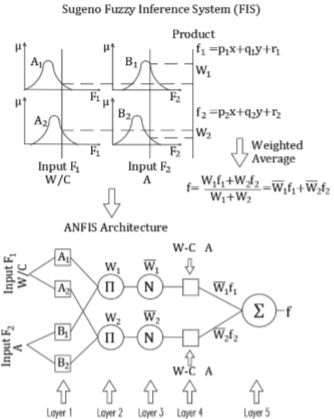
METHODOLOGY
Experimental Data
Table 1 shows the experimental input – output data obtained from Kostic & Vasovic (2015) that will be used to create two Sugeno (FIS) by
subtractive clustering method and ANFIS. The letter A denotes the age of concrete, F/T is the number of freeze/thaw cycles, and S is concrete compressive strength. Training data is the data used to generate the ANFIS model while testing and checking data are used for verifying the performance of the model.
Table1
Concrete compressive strength
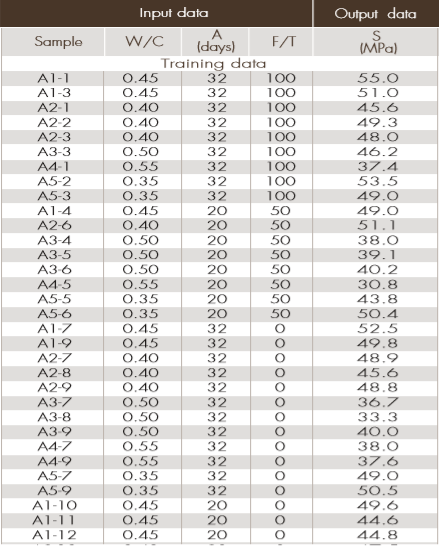
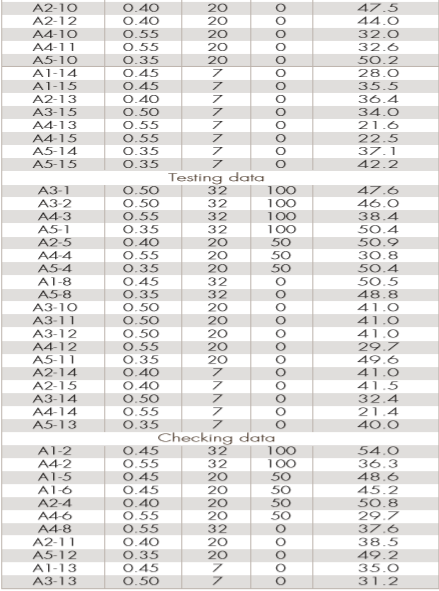
Subtractive clustering parameters
The following are the parameters used to partition the data: accept ratio (e) = 0.5, reject ratio (ε) = 0.15, range of influence (ra) = 0.4 and a squash factor (n) = 2.0; where ε is a threshold above which a data
point is accepted to be a cluster center and ε is a threshold below which a data point will be rejected as a cluster center. Once such parameters are applied, cluster centers (ci) and sigmas (σi) are calculated by the subtractive clustering method. They become the parameters of each Gaussian MF (see Figure 2) and the number of rules for ANFIS. In this case 11 cluster centers were found and thus 11 MFs and rules were generated.
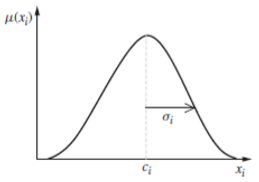
Figure 2. Parameters of a Gaussian membership function
ANFIS model
As mentioned before, ANFIS consists of five layers and the membership values of each input are computed in layer 1. Figure 2 shows a typical Gaussian MF used by ANFIS and Table 2 contains all Gaussian parameters for the 11 MFs. When all parameters of Gaussian MFs are defined, it is possible to compute the corresponding membership value for each input by using Eq. (7). Table 3 comprises all calculated membership values of each input. Table 4 summarizes the results of the consequent parameters of each function f_i while Table 5 contains the values of firing strengths, normalized firing strengths and weighted output of each rule (i.e., the operations performed in layers 2,3, and 4).
Table 2.
Gaussian membership function parameters
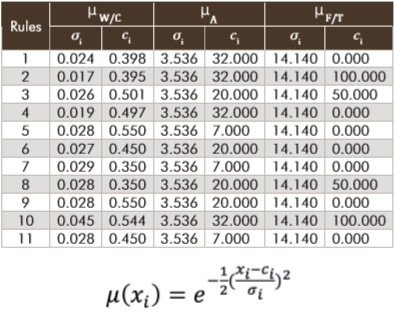
Table 3.
Membership values
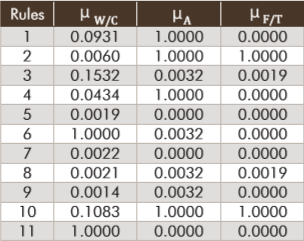
Table 4.
Consequent parameters
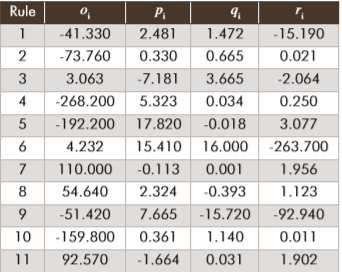
Table 5.
Results of layers 2, 3, and 4
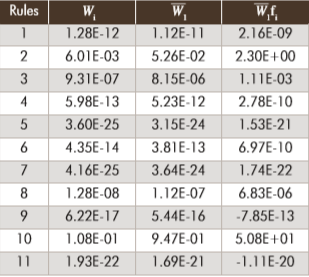
RESULTS
Kostic & Vasovic (2015) utilized artificial neural networks ANN to develop models for predicting compressive strength of basic concrete mixture by using three different learning algorithms with six hidden nodes: Levenberg–Marquardt, scaled conjugate gradient, and onestep-secant OSS as mentioned before and the results of strength are comprised in columns (1), (2), and (3) of Table 6 respectively. Similarly, the results of applying FISs with 11 and 27 rules through subtractive clustering method and ANFIS are depicted in column (4) and (5) of Table 6 respectively. The values in column (5) correspond to another ANFIS model created by using the following parameters for clustering input data: accept ratio (ε) = 0.525, reject ratio (ε) = 0.15, range of influence (ra) = 0.35 and a squash factor (η) = 1.25. These parameters produced 27 clusters and hence 27 Gaussian MFs and rules, and this model was created to study the effect of the number of MFs and rules on FIS outputs. The rows that are in gray are the data tuples that will be used for validating FIS models.
Table 6.
Results of ANN and FISs for concrete compressive strengt
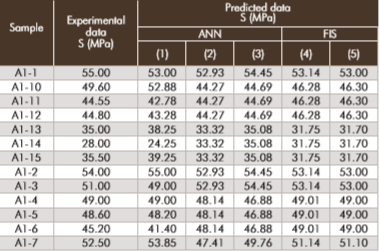
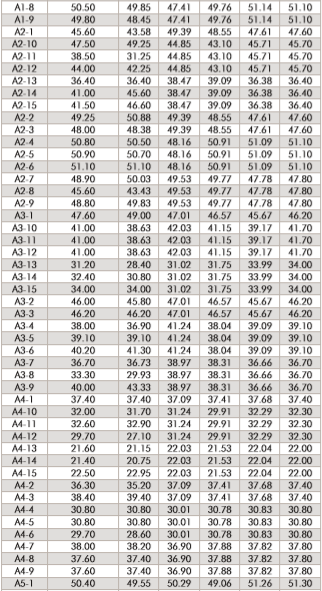

MODEL VALIDATION
Predicted versus experimental data plots were used for model validation. Training data should not be used to see how well a FIS model performs; instead, checking or testing data should be used (Tesfamariam, 2007). Thus in order to test the performance of the two different methods (i.e., ANN and FISs) checking data will be used as validation data for the two FISs to compare with the results obtained by Kostic & Vasovic (2015). Table 7 summarizes the results of R squared (R2) values and the corresponding standard error (SE) for each of method.
Table 7
R squared values and Standard Errors

CONCLUSIONS
The results of the study indicate that FISs perform slightly better than ANN when estimating concrete compressive strength. It can be inferred from Table 7 that all R2 values are high, meaning that all models perform well when predicting responses for new observations (i.e., concrete compressive strength).
All FIS models have R2 values greater than 90% while only the ANN model using Levenberg–Marquardt learning algorithm has an R2 greater than 90% (i.e., 91.5%), suggesting that FISs works very well when mapping input – output data even with a few number of rules (i.e., 11 rules). Regarding errors, FIS models produce less SE compared with the best ANN model (i.e., 2.795 and 2.816 are lower than 2.818).
A FIS is a very efficient technique when mapping input – output data. In this project, 45 observations were used to train the model and only 11 rules produced an acceptable model with a high R2 value of 90.1%. Increasing the number of rules to try to minimize the standard error was not effective. The results show that there is not a significant improvement when using more rules (i.e., 27 rules) are utilized. Therefore, the FIS model with 11 rules should be maintained for estimating new data.
Another conclusion that can be derived from this study is that FISs are not “black box” systems like ANN where complex calculations are performed inside to generate outputs. Instead, FISs such as Sugeno type FISs allow the experimenter or researcher to gain some knowledge of the system due to use of the deductive form. This is accomplished by using natural language expressions such as fuzzy rules (i.e., IF premise THEN conclusion).
Moreover, the number of rules is an important parameter of any FIS and depends on the complexity of the system. In addition, the number of rules should be paid special attention and minimized by trial and error so that output errors stay within desired ranges. In other words, the parameters for the clustering method can be adjusted accordingly in order to keep the number of rules small. Thus, as a rule of thumb, the number of rules should be as few as possible, meaning that the less number of rules, the better.
REFERENCES
Bezdek, J. C. (1981). Pattern Recognition with Fuzzy Objective Function Algorithms. In Advanced Applications in Pattern Recognition; Advanced applications in pattern recognition. Retrieved from Springer Link http://dx.doi.org/10.1007/978-1-4757-0450-1
Chiu, S. L. (1994). Fuzzy model identification based on cluster estimation. Journal of Intelligent & Fuzzy Systems, 2(3), 267-278.
Jang, J.-S. R., Sun, C.-T., & Mizutani, E. (1997). Neuro-fuzzy and soft computing : a computational approach to learning and machine intelligence. Upper Saddle River, NJ :: Prentice Hall.
Jang, J. S. R. (1993). ANFIS: Adaptive-Network-Based Fuzzy Inference System. IEEE transactions on systems, man, and cybernetics., 23(3), 665-685.
Kim, J. I., Kim, D. K., Feng, M. Q., & Yazdani, F. (2004). Application of neural networks for estimation of concrete strength. Journal of Materials in Civil Engineering, 16(3), 257-264.
Kostic, S., & Vasovic, D. (2015). Prediction model for compressive strength of basic concrete mixture using artificial neural networks. Neural Computing and Applications, 26(5), 1005-1024.
Passino, K. M., & Yurkovich, S. (1998). Fuzzy control. Menlo Park, Calif. :: Addison-Wesley.
Ross, T. J. (2010). Fuzzy logic with engineering applications (3rd ed. ed.). Chichester, U.K. :: John Wiley.
Sugeno, M., & Yasukawa, T. (1993). A fuzzy-logic-based approach to qualitative modeling. IEEE Transactions on fuzzy systems, 1(1), 7-31.
Tesfamariam, S. (2007). Adaptive Network–Fuzzy Inferencing to Estimate Concrete Strength Using Mix Design. Journal of Materials in Civil Engineering, 19(7), 550-560. Retrieved from
Yager, R. R., & Filev, D. P. (1994a). Essentials of fuzzy modeling and control. New York :: Wiley, 408 pp.
Yager, R. R., & Filev, D. P. (1994b). Generation of fuzzy rules by mountain clustering. Journal of Intelligent & Fuzzy Systems, 2(3), 209-219.
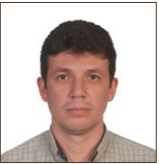 JORGE LUIS SANTAMARIA C.
JORGE LUIS SANTAMARIA C.
jsantamaria@uce.edu.ecu
Biography:
ABOUT THE JOURNAL
“Vinculos –ESPE” is a peer-reviewed journal published by Universidad de las Fuerzas Armadas – ESPE through which faculty, staff, students, and community partners disseminate scholarly works that integrate teaching, research, and community engagement in all disciplines and forms. This special issue is commemorating the 60 th Anniversary of the Ecuador Fulbright Commission.
“Vinculos-ESPE” invites to the Fulbright community to look back at the last sixty decades, sums up where we are now, and offers glimpses into the future. Thought- provoking essays, story of catalyst of change, related to scientific discovery, cultural understanding, education, entrepreneurship, economic development, human rights, or any other field driving progress. Diverse contributions from all background are welcome!
TYPES OF CONTRIBUTIONS
Essays - Perspective, opinion, and commentary that present a reflection on the impact of the experience in the personal and professional life. For instance, how this experience helped to shape your personal point of view critiquing widespread notions pertaining to a field. It is recommended not to exceed 10,000 characters (with spaces)
Technical Note - Notes are short papers that present significant new observations and methodological advances. Notes may contain results that are not sufficiently elaborated or developed as to justify an article, but are still of considerable potential significance. It is recommended not to exceed 10,000 characters (with spaces)
Research Article - Detailed studies reporting original research and are classified as primary literature. They include title, abstract, introduction, methods, results, discussion/conclusion, acknowledgements, and references. It is recommended not to exceed 20,000 characters (with spaces).
Review -synthetic overview of a subfield. These papers are expected to include discussion of new directions, new syntheses, and resolutions of old questions. It is recommended not to exceed 20,000 characters (with spaces).
Press release.- Short science news articles to communicate important information to decision-makers, practitioners, and public in general.
It increases awareness of science in the public domain and a broad appreciation of scientific progress, increases awareness of specific scientific projects, instruments or organization missions. It is recommended not to exceed 600 characters (with spaces).
PREPARING YOUR PAPER
Style Guidelines
Papers must be written in American English and should follow the style guidelines described in the Publication Manual of the American Psychological Association (6th ed.). Merriam-Webster’s Collegiate Dictionary (11th ed.) should be consulted for spelling.
Formatting and Templates
Papers may be submitted in Word. Figures should be saved separately from the text. The main document should be single-spaced, with one-inch margins on all sides, and all pages should be numbered consecutively. Text should appear in 11-point Futura.
Checklist: What to include
Author Agreement/Use of Third-Party Material
Authors are responsible for obtaining permission to reproduce copyrighted material from other sources. As an author, you are required to secure permission if you want to reproduce any figure, table or extract text from any other source. This applies to direct reproduction as well as “derivative reproduction” (for which you have created a new figure or table which derives substantially from a copyrighted source).
Submitting Your Paper
Please read the guidelines above and then submits your paper to vínculos@espe.edu.ec, until December 1, 2017.
Our publication policies
Our detailed publication policies can be found in the Editorial and Publishing policies file [http://journal.espe.edu.ec/index.php/vínculos]. Our compiled policies cover various topics like conflict of interest, authorship, copyright and license policies. A summary of the main policies are below. We will follow recommendations by the Committee on Publication Ethics (COPE) https://publicationethics.org/
All articles are subject to peer review before they can be accepted for publication. The acceptance criteria for all papers are the quality and originality of the research and its significance to journal readership.
All articles published by “Vínculos-ESPE”are made freely and permanently accessible online immediately upon publication, without subscription charges or registration barriers.
There are no page charges for publishing in “Vínculos-ESPE”.
In case of any questions, please contact the editors
Jéssica Duchicela at jiduchicela@espe.edu.ec
ABOUT VÍNCULOS ESPE
• Vínculos ESPE is a publication of Universidad de las Fuerzas Armadas ESPE.
• Vínculos - ESPE is a peer-reviewed journal published 3 times a year dedicated to the promotion of the diversity of
interactions between technology, science and society.
• The journal is available online at http://journal.espe.edu.ec/index.php/vinculos. Please visit the site for submission
instructions and latest information.
• If you have any questions, do get in touch with the central office at vinculos@espe.edu.ec